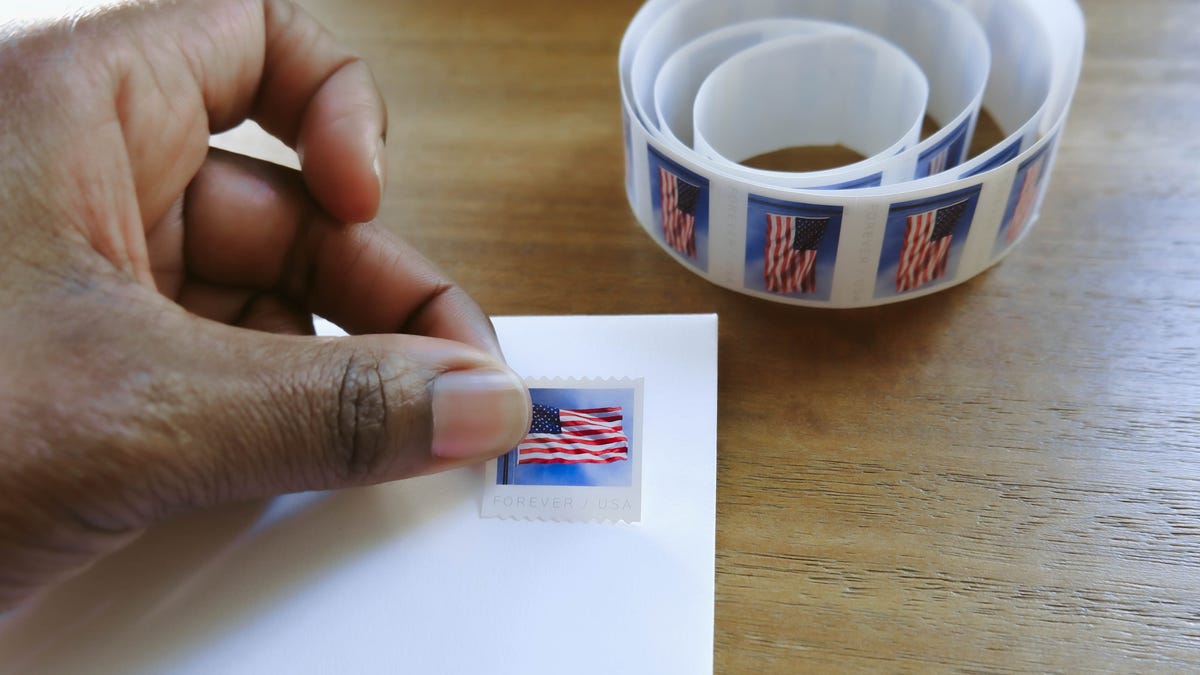Postage Prices Just Went Up Again. Here's How Much Stamps Cost Now

On Sunday, first-class stamps went from 60 cents to 63 cents.
What's happening
The price of first-class stamps, packages and other services went up on Jan. 22.
Why it matters
The rate hike is due partly to the US Postal Service's massive debt: The agency has an annual budget deficit of $10 billion.
The US Postal Service raised the price of stamps on Sunday, with a first-class stamp going from 60 to 63 cents.
Prices for international mail and metered letters also rose, as did fees for post office boxes, money orders and other special services.
Stamps just rose to 60 cents in July 2022, up from 58 cents. The National Postal Policy Council, a trade association for corporations that use stamped mail, called the back-to-back increases "unwelcome burdens."
But the Postal Service says the new rates are still "competitive."
"Prices of the US Postal Service remain among the most affordable in the world," the agency said in a statement in October.
Here's what you need to know about stamp prices, including what the new rates are and what you can do to delay paying more.
Read more: What's the Cheapest Way to Ship: UPS, FedEx or US Postal Service?
How much is the price of stamps going up?
The cost of first-class mail went up about 4.2% on average. First-class stamps increased from 60 cents to 63 cents, while international letters and postcards jumped from $1.40 to $1.45.
| Product | Previous price | Current price |
|---|---|---|
Letters (1 ounce) | 60 cents | 63 cents |
Letters (metered 1 ounce) | 57 cents | 60 cents |
Domestic postcards | 44 cents | 48 cents |
International postcards | $1.40 | $1.45 |
International letter (1 ounce) | $1.40 | $1.45 |
You can buy stamps at online retailers like Amazon or directly at the US Postal Service website.
Did shipping rates increase, too?
The US Postal Service increased the cost of sending packages via Priority Mail by about 5.5%. Priority Mail Express became 6.6% more expensive, First Class Package Service prices were bumped up by 7.8% and Priority Mail commercial rates increased by about 3.6%.
The new rates are still "well below the rate of inflation," the Postal Service said in a statement.
There was no price increase for Parcel Select Ground or USPS Connect Local, which allows businesses to offer same-day and next-day delivery for local customers.
More detailed pricing information can be found on the Postal Service's Postal Explorer website.
Domestic Priority Mail Flat Rate changes
| Product | Previous | New |
|---|---|---|
| Small flat-rate box | $10.40 | $10.20 |
| Medium flat-rate box | $17.05 | $17.10 |
| Large flat-rate box | $22.45 | $22.80 |
| APO/FPO large flat-rate box | $20.95 | $21.20 |
| Regular flat-rate envelope | $9.90 | $9.65 |
| Legal flat-rate envelope | $10.20 | $9.95 |
| Padded flat-rate envelope | $10.60 | $10.40 |
Will the post office raise prices again?
It's definitely possible. The rate hikes are part of Postmaster General Louis DeJoy's 10-year Delivering for America plan, intended to chip away at the Postal Service's mammoth debt.
The agency has an annual budget deficit of $10 billion and, at the end of fiscal year 2020, was carrying $188 billion in debts and unfunded liabilities, the Government Accountability Office reported -- mostly from underfunding of workers' pensions and retiree health care benefits.
The Postal Service generally receives no tax dollars for operating expenses, relying on the sale of postage, products and services to fund its operations.
DeJoy's plans include increasing postage rates, lengthening delivery times and reducing post office hours. In October 2021, the Postal Service started lengthening delivery times for about a third of its volume, meaning that letters, parcels and magazines that took two or three days can now take up to five to arrive.
The nonprofit NPCC urged the Postal Regulatory Commission to consider whether it could discourage the Postal Service from filing multiple rate changes in a 12-month period. The Commission countered that "nothing in the statute or regulations dictates the frequency of price adjustments or the timing of when they are to occur."
It encouraged the Postal Service to set a schedule for price adjustments "that minimizes costs and disruptions."

